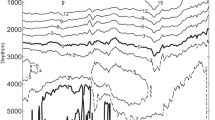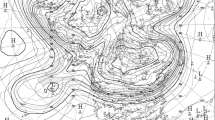Abstract
The factors controlling equatorial Atlantic winds in boreal spring are examined using both observations and general circulation model (GCM) simulations from the coupled model intercomparison phase 5. The results show that the prevailing surface easterlies flow against the attendant pressure gradient and must therefore be maintained by other terms in the momentum budget. An important contribution comes from meridional advection of zonal momentum but the dominant contribution is the vertical transport of zonal momentum from the free troposphere to the surface. This implies that surface winds are strongly influenced by conditions in the free troposphere, chiefly pressure gradients and, to a lesser extent, meridional advection. Both factors are linked to the patterns of deep convection. Applying these findings to GCM errors indicates, that, consistent with the results of previous studies, the persistent westerly surface wind bias found in most GCMs is due mostly to precipitation errors, in particular excessive precipitation south of the equator over the ocean and deficient precipitation over equatorial South America. Free tropospheric influences also dominate the interannual variability of surface winds in boreal spring. GCM experiments with prescribed climatological sea-surface temperatures (SSTs) indicate that the free tropospheric influences are mostly associated with internal atmospheric variability. Since the surface wind anomalies in boreal spring are crucial to the development of warm SST events (Atlantic Niños), the results imply that interannual variability in the region may rely far less on coupled air–sea feedbacks than is the case in the tropical Pacific.











Similar content being viewed by others
References
Adler RF, Huffman GJ, Chang A, Ferraro R, Xie P, Janowiak J, Rudolf B, Schneider U, Curtis S, Bolvin D, Gruber A, Susskind J, Arkin P (2003) The version 2 global precipitation climatology project (GPCP) monthly precipitation analysis (1979-Present). J Hydrometeor 4:1147–1167
Ahlgrimm M, Randall D (2006) Diagnosing monthly mean boundary layer properties from reanalysis data using a bulk boundary layer model. J Atmos Sci 63:998–1012
Alexander MA, Bladé I, Newman M, Lanzante JR, Lau N-C, Scott JD (2002) The atmospheric bridge: the influence of ENSO teleconnections on air–sea interaction over the global oceans. J Clim 15:2205–2231
Back LE, Bretherthon CS (2009) On the relationship between SST gradients, boundary layer winds and convergence over the tropical oceans. J Clim 22:4182–4196
Back LE, Bretherton CS (2009) A simple model of climatological rainfall and vertical motion patterns over the tropical oceans. J Clim 22:6477–6497
Bjerknes J (1969) Atmospheric teleconnections from the equatorial Pacific. Mon Weather Rev 97:163–172
Chan KM, Wood R (2013) The seasonal cycle of planetary boundary layer depth determined using COSMIC radio occultation data. J Geophys Res 118:12422–12434
Chang P, Fang Y, Saravanan R, Ji L, Seidel H (2006) The cause of the fragile relationship between the Pacific El Niño and the Atlantic Niño. Nature 443:324–328
Chang CY, Carton JA, Grodsky SA, Nigam S (2007) Seasonal climate of the tropical Atlantic sector in the NCAR community climate system model 3: error structure and probable causes of errors. J Clim 20:1053–1070
Chang CY, Nigam S, Carton JA (2008) Origin of the springtime westerly bias in equatorial Atlantic surface winds in the community atmosphere model version 3 (CAM3) simulation. J Clim 21:4766–4778
Chelton DB et al (2001) Observations of coupling between surface wind stress and sea surface temperature in the eastern tropical Pacific. J Clim 14:1479–1498
Chiang JCH, Zebiak SE, Cane MA (2001) Relative roles of elevated heating and surface temperature gradients in driving anomalous surface winds over tropical oceans. J Atmos Sci 58:1371–1394
Davey MK et al (2002) STOIC: a study of coupled model climatology and variability in topical ocean regions. Clim Dyn 18:403–420
Dee DP et al (2011) The ERA-interim reanalysis: configuration and performance of the data assimilation system. Q J R Meteorol Soc 137:553–597
Deser C (1993) Diagnosis of the surface momentum balance over the tropical Pacific Ocean. J Clim 6:64–74
deSzoeke SP, Bretherton CS, Bond NA, Cronin MF, Morely BM (2005) EPIC 95°W observations of the eastern Pacific atmospheric boundary layer from the cold tongue to the ITCZ. J Atmos Sci 62(2):426
Dunbar S et al (2006) QuikSCAT science data product user manual, version 3.0, Doc. D-18053—Rev A, Jet Propul. Lab., Pasadena, Calif. ftp://podaac-ftp.jpl.nasa.gov/allData/quikscat/L2B/docs/QSUG_v3.pdf
Emanuel KA, Neelin JD, Bretherton CS (1994) On large-scale circulations in convecting atmospheres. Q J R Met Soc 120:1111–1143
Foltz GR, McPhaden MJ (2010) Abrupt equatorial wave-induced cooling of the Atlantic cold tongue in 2009. Geophys Res Lett 37:L24605. doi:10.1029/2010GL045522
Gill AE (1980) Some simple solutions for heat-induced tropical circulation. Q J R Meteorol Soc 106:447–462
Jin F–F (1997) An equatorial ocean recharge paradigm for ENSO. Part I: conceptual model. J Atmos Sci 54:811–829
Keenlyside NS, Latif M (2007) Understanding equatorial Atlantic interannual variability. J Clim 20:131–142
Lindzen RS, Nigam S (1987) On the role of the sea surface temperature gradients in forcing the low-level winds and convergence in the tropics. J Atmos Sci 44:2418–2436
Lübbecke JF, McPhaden MJ (2012) On the inconsistent relationship between Pacific and Atlantic Niños. J Clim 25:4294–4303
Lübbecke JF, Böning CW, Keenlyside N, Xie S-P (2010) On the connection between Benguela and equatorial Atlantic Niños and the role of the South Atlantic anticyclone. J Geophys Res 115:C09015. doi:10.1029/2009JC005964
McGauley M, Zhang C, Bond N (2004) Large-scale characteristics of the atmospheric boundary layer in the Eastern Pacific cold tongue-ITCZ region. J Clim 17:3907–3920
Neelin JD, Battisti DS, Hirst AC, Jin FF, Wakata Y, Yamagata T, Zebiak S (1998) ENSO theory. J Geophys Res 103:14261–14290
Okumura Y, Xie S-P (2004) Interaction of the Atlantic equatorial cold tongue and African monsoon. J Clim 17:3588–3601
Philander SG (1990) El Niño, La Niña, and the southern oscillation. International Geophysics Series, 46, Academic Press Inc., London
Richter I, Xie S-P (2008) On the origin of equatorial Atlantic biases in coupled general circulation models. Clim Dyn 31:587–598
Richter I, Behera SK, Masumoto Y, Taguchi B, Komori N, Yamagata T (2010) On the triggering of Benguela Niños: remote equatorial versus local influences. Geophys Res Lett 37(L20604). doi:10.1029/2010GL044461
Richter I, Xie S-P, Wittenberg AT, Masumoto Y (2012) Tropical Atlantic biases and their relation to surface wind stress and terrestrial precipitation. Clim Dyn 38:985–1001. doi:10.1007/s00382-011-1038-9
Richter I, Behera SK, Masumoto Y, Taguchi B, Sasaki H, Yamagata T (2013) Multiple causes of interannual sea surface temperature variability in the equatorial Atlantic Ocean. Nat Geosci 6:43–47
Richter I, Xie S-P, Behera SK, Doi T, Masumoto Y (2014) Equatorial Atlantic variability and its relation to mean state biases in CMIP5. Clim Dyn 42:171–188. doi:10.1007/s00382-012-1624-5
Servain J, Picaut J, Merle J (1982) Evidence of remote forcing in the equatorial Atlantic Ocean. J Phys Oceanogr 12:457–463
Sobel AH, Bretherton CS (2000) Modeling tropical precipitation in a single column. J Clim 13:4378–4392
Stevens B, Duan JJ, McWilliams JC, Münnich M, Neelin JD (2002) Entrainment, Rayleigh friction, and boundary layer winds over the tropical Pacific. J Clim 15:30–44
Stockdale TN, Balmaseda MA, Vidard A (2006) Tropical Atlantic SST prediction with coupled ocean–atmosphere GCMs. J Clim 19:6047–6061
Tozuka T, Doi T, Miyasaka T, Keenlyside N, Yamagata T (2011) Key factors in simulating the equatorial Atlantic zonal sea surface temperature gradient in a coupled general circulation model. J Geophys Res 116(C06010), doi:10.1029/2010JC006717
Wahl S, Latif M, Park W, Keenlyside N (2009) On the Tropical Atlantic SST warm bias in the Kiel Climate Model. Clim Dyn 36:5. doi:10.1007/s00382-009-0690-9
Wallace JM, Mitchell TP, Deser C (1989) The influence of sea-surface temperature on surface wind in the Eastern Equatorial Pacific: seasonal and interannual variability. J Clim 2:1492–1499
Wallace JM, Smith C, Bretherton CS (1992) Singular value de-composition of wintertime sea surface temperature and 500-mb height anomalies. J Clim 5:561–576
Woodruff SD et al (2011) ICOADS Release 2.5: extensions and enhancements to the surface marine meteorological archive. Int J Climatol 31:951–967
Xie S-P (2004) Satellite observations of cool ocean–atmosphere interaction. Bull Am Meteor Soc 85:195–208
Xie S-P, Carton JA (2004) Tropical Atlantic variability: patterns, mechanisms, and impacts. In: Wang C, Xie S-P, Carton JA (eds) Earth climate: the ocean–atmosphere interaction, Geophysical Monograph, 147, AGU, Washington D.C., pp 121–142
Zebiak SE (1993) Air–sea interaction in the equatorial Atlantic region. J Clim 6:1567–1586
Zermeno D, Zhang C (2013) Possible root causes of the surface westerly biases over the equatorial Atlantic in global climate models. J Clim 26:8154–8168
Acknowledgments
The authors thank the three anonymous reviewers for their constructive comments. We acknowledge the World Climate Research Programme’s Working Group on Coupled Modelling, which is responsible for CMIP, the US Department of Energy’s Program for Climate Model Diagnosis and Intercomparison which provides coordinating support and led development of software infrastructure for CMIP, and the climate modeling groups for making available their model output. SPX is supported by NOAA.
Author information
Authors and Affiliations
Corresponding author
Additional information
This paper is a contribution to the special issue on tropical Atlantic variability and coupled model climate biases that have been the focus of the recently completed Tropical Atlantic Climate Experiment (TACE), an international CLIVAR program (http://www.clivar.org/organization/atlantic/tace). This special issue is coordinated by William Johns, Peter Brandt, and Ping Chang, representatives of the TACE Observations and TACE Modeling and Synthesis working groups.
Rights and permissions
About this article
Cite this article
Richter, I., Behera, S.K., Doi, T. et al. What controls equatorial Atlantic winds in boreal spring?. Clim Dyn 43, 3091–3104 (2014). https://doi.org/10.1007/s00382-014-2170-0
Received:
Accepted:
Published:
Issue Date:
DOI: https://doi.org/10.1007/s00382-014-2170-0




